《DSP using MATLAB》Problem 3.1
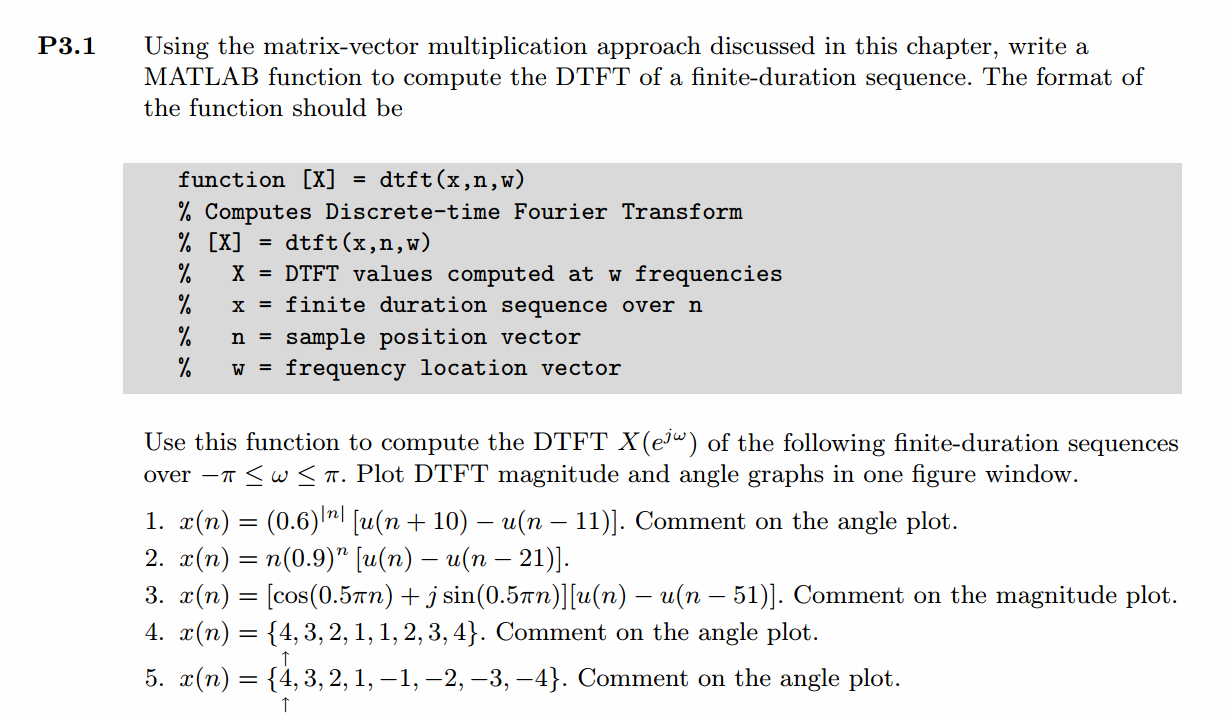
先写DTFT子函数:
function [X] = dtft(x, n, w) %% ------------------------------------------------------------------------
%% Computes DTFT (Discrete-Time Fourier Transform)
%% of Finite-Duration Sequence
%% Note: NOT the most elegant way
% [X] = dtft(x, n, w)
% X = DTFT values computed at w frequencies
% x = finite duration sequence over n
% n = sample position vector
% w = frequency location vector M = 500;
k = [-M:M]; % [-pi, pi]
%k = [0:M]; % [0, pi]
w = (pi/M) * k; X = x * (exp(-j*pi/M)) .^ (n'*k);
% X = x * exp(-j*n'*pi*k/M) ;
下面开始利用上函数开始画图。结构都一样,先显示序列x(n),在进行DTFT,画出幅度响应和相位响应。
代码:
%% ------------------------------------------------------------------------
%% Output Info about this m-file
fprintf('\n***********************************************************\n');
fprintf(' <DSP using MATLAB> Problem 3.1 \n\n'); banner();
%% ------------------------------------------------------------------------ % ----------------------------------
% x1(n)
% ----------------------------------
n1_start = -11; n1_end = 13;
n1 = [n1_start : n1_end]; x1 = 0.6 .^ (abs(n1)) .* (stepseq(-10, n1_start, n1_end)-stepseq(11, n1_start, n1_end)); figure('NumberTitle', 'off', 'Name', 'Problem 3.1 x1(n)');
set(gcf,'Color','white');
stem(n1, x1);
xlabel('n'); ylabel('x1');
title('x1(n) sequence'); grid on; M = 500;
k = [-M:M]; % [-pi, pi]
%k = [0:M]; % [0, pi]
w = (pi/M) * k; [X1] = dtft(x1, n1, w); magX1 = abs(X1); angX1 = angle(X1); realX1 = real(X1); imagX1 = imag(X1); figure('NumberTitle', 'off', 'Name', 'Problem 3.1 DTFT');
set(gcf,'Color','white');
subplot(2,2,1); plot(w/pi, magX1); grid on;
title('Magnitude Part');
xlabel('frequency in \pi units'); ylabel('Magnitude');
subplot(2,2,3); plot(w/pi, angX1/pi); grid on;
title('Angle Part');
xlabel('frequency in \pi units'); ylabel('Radians/\pi');
subplot('2,2,2'); plot(w/pi, realX1); grid on;
title('Real Part');
xlabel('frequency in \pi units'); ylabel('Real');
subplot('2,2,4'); plot(w/pi, imagX1); grid on;
title('Imaginary Part');
xlabel('frequency in \pi units'); ylabel('Imaginary'); figure('NumberTitle', 'off', 'Name', 'Problem 3.1 DTFT of x1(n)');;
set(gcf,'Color','white');
subplot(2,1,1); plot(w/pi, magX1); grid on;
title('Magnitude Part');
xlabel('frequency in \pi units'); ylabel('Magnitude');
subplot(2,1,2); plot(w/pi, angX1); grid on;
title('Angle Part');
xlabel('frequency in \pi units'); ylabel('Radians'); % -------------------------------------
% x2(n)
% -------------------------------------
n2_start = -1; n2_end = 22;
n2 = [n2_start : n2_end]; x2 = (n2 .* (0.9 .^ n2)) .* (stepseq(0, n2_start, n2_end) - stepseq(21, n2_start, n2_end)); figure('NumberTitle', 'off', 'Name', 'Problem 3.1 x2(n)');
set(gcf,'Color','white');
stem(n2, x2);
xlabel('n'); ylabel('x2');
title('x2(n) sequence'); grid on; M = 500;
k = [-M:M]; % [-pi, pi]
%k = [0:M]; % [0, pi]
w = (pi/M) * k; [X2] = dtft(x2, n2, w); magX2 = abs(X2); angX2 = angle(X2); realX2 = real(X2); imagX2 = imag(X2); figure('NumberTitle', 'off', 'Name', 'Problem 3.1 DTFT of x2(n)');;
set(gcf,'Color','white');
subplot(2,1,1); plot(w/pi, magX2); grid on;
title('Magnitude Part');
xlabel('frequency in \pi units'); ylabel('Magnitude');
subplot(2,1,2); plot(w/pi, angX2); grid on;
title('Angle Part');
xlabel('frequency in \pi units'); ylabel('Radians'); % -------------------------------------
% x3(n)
% -------------------------------------
n3_start = -1; n3_end = 52;
n3 = [n3_start : n3_end]; x3 = (cos(0.5*pi*n3) + j * sin(0.5*pi*n3)) .* (stepseq(0, n3_start, n3_end) - stepseq(51, n3_start, n3_end)); figure('NumberTitle', 'off', 'Name', 'Problem 3.1 x3(n)');
set(gcf,'Color','white');
stem(n3, x3);
xlabel('n'); ylabel('x3');
title('x3(n) sequence'); grid on; M = 500;
k = [-M:M]; % [-pi, pi]
%k = [0:M]; % [0, pi]
w = (pi/M) * k; [X3] = dtft(x3, n3, w); magX3 = abs(X3); angX3 = angle(X3); realX3= real(X3); imagX3 = imag(X3); figure('NumberTitle', 'off', 'Name', 'Problem 3.1 DTFT of x3(n)');;
set(gcf,'Color','white');
subplot(2,1,1); plot(w/pi, magX3); grid on;
title('Magnitude Part');
xlabel('frequency in \pi units'); ylabel('Magnitude');
subplot(2,1,2); plot(w/pi, angX3); grid on;
title('Angle Part');
xlabel('frequency in \pi units'); ylabel('Radians'); % -------------------------------------
% x4(n)
% -------------------------------------
n4_start = 0; n4_end = 7;
n4 = [n4_start : n4_end]; x4 = [4:-1:1, 1:4]; figure('NumberTitle', 'off', 'Name', 'Problem 3.1 x4(n)');
set(gcf,'Color','white');
stem(n4, x4, 'r', 'filled');
xlabel('n'); ylabel('x4');
title('x4(n) sequence'); grid on; M = 500;
k = [-M:M]; % [-pi, pi]
%k = [0:M]; % [0, pi]
w = (pi/M) * k; [X4] = dtft(x4, n4, w); magX4 = abs(X4); angX4 = angle(X4); realX4= real(X4); imagX4 = imag(X4); figure('NumberTitle', 'off', 'Name', 'Problem 3.1 DTFT of x3(n)');;
set(gcf,'Color','white');
subplot(2,1,1); plot(w/pi, magX4); grid on;
title('Magnitude Part');
xlabel('frequency in \pi units'); ylabel('Magnitude');
subplot(2,1,2); plot(w/pi, angX4); grid on;
title('Angle Part');
xlabel('frequency in \pi units'); ylabel('Radians'); % -------------------------------------
% x5(n)
% -------------------------------------
n5_start = 0; n5_end = 7;
n5 = [n5_start : n5_end]; x5 = [4:-1:1, -1:-1:-4]; figure('NumberTitle', 'off', 'Name', 'Problem 3.1 x5(n)');
set(gcf,'Color','white');
stem(n5, x5, 'r', 'filled');
xlabel('n'); ylabel('x5');
title('x5(n) sequence'); grid on; M = 500;
k = [-M:M]; % [-pi, pi]
%k = [0:M]; % [0, pi]
w = (pi/M) * k; [X5] = dtft(x5, n5, w); magX5 = abs(X5); angX5 = angle(X5); realX5= real(X5); imagX5 = imag(X5); figure('NumberTitle', 'off', 'Name', 'Problem 3.1 DTFT of x5(n)');
set(gcf,'Color','white');
subplot(2,1,1); plot(w/pi, magX5); grid on;
title('Magnitude Part');
xlabel('frequency in \pi units'); ylabel('Magnitude');
subplot(2,1,2); plot(w/pi, angX5); grid on;
title('Angle Part');
xlabel('frequency in \pi units'); ylabel('Radians');
运行结果:
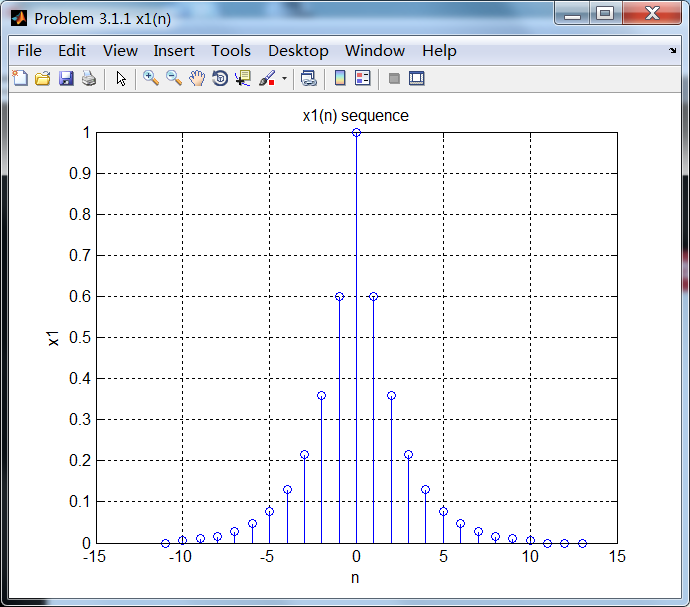

相位响应是关于ω=0偶对称的。
序列2:

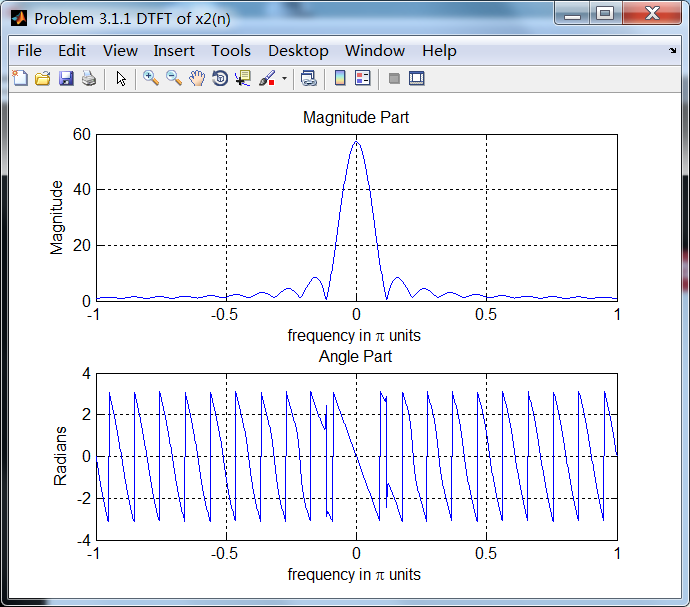
序列3:
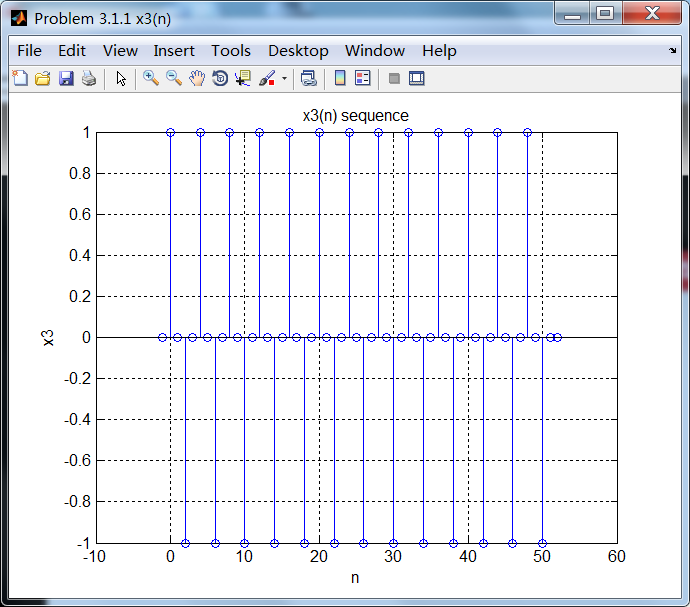
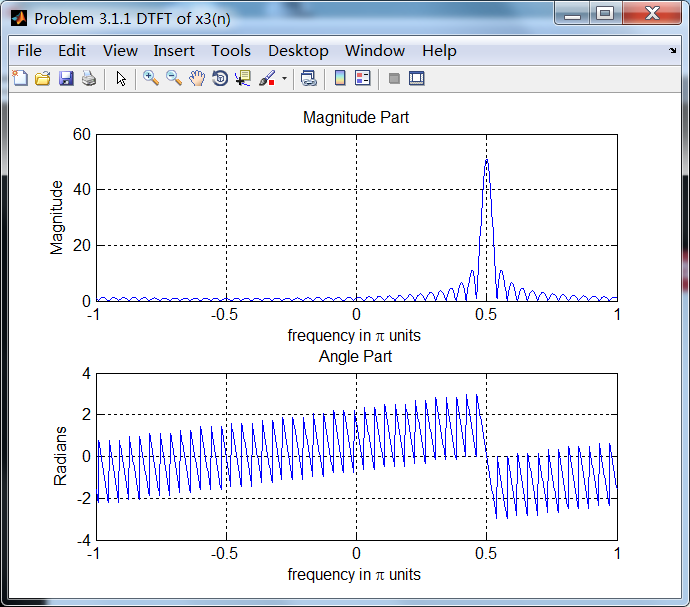
序列3的主要频率分量位于ω=0.5π。
序列4:
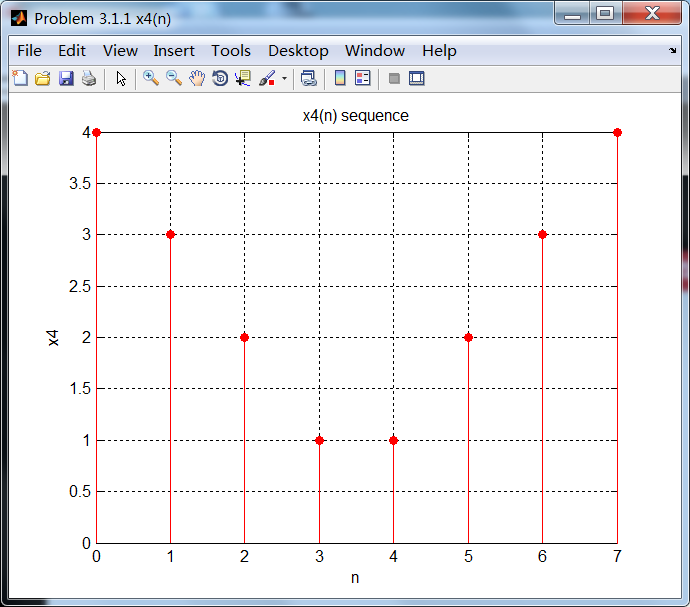
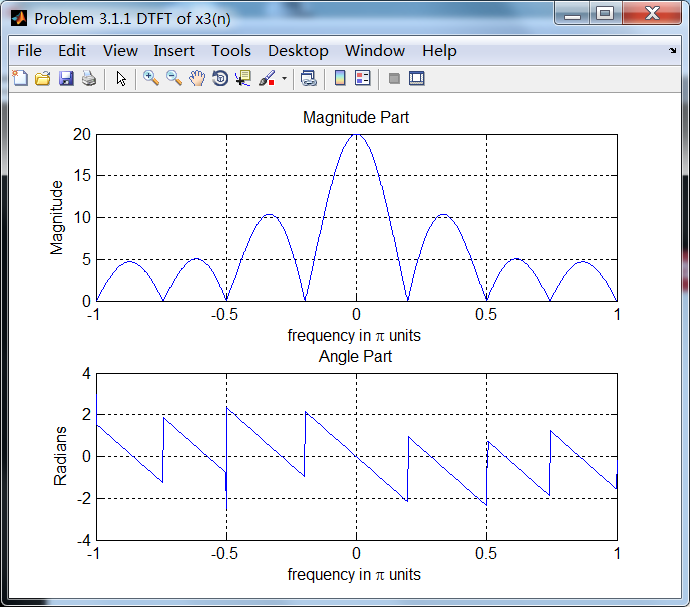
序列4的相位谱关于ω= 0奇对称。
序列5:

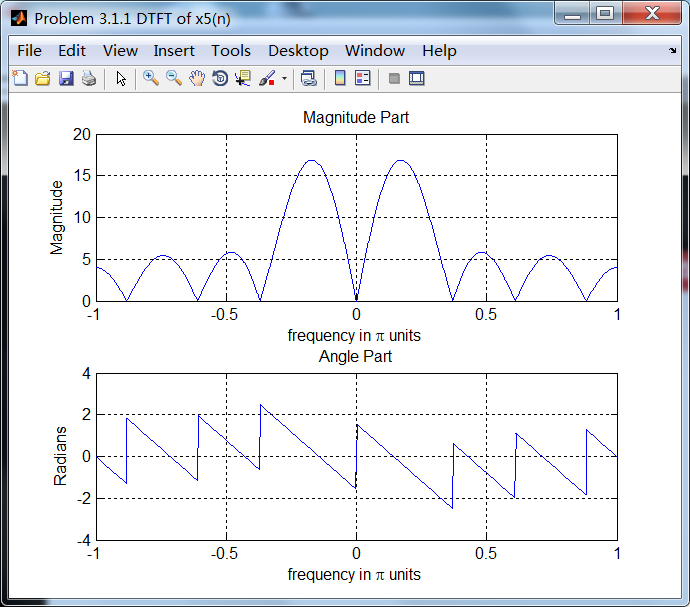
序列5的相位谱关于ω=0奇对称。
《DSP using MATLAB》Problem 3.1的更多相关文章
- 《DSP using MATLAB》Problem 7.27
代码: %% ++++++++++++++++++++++++++++++++++++++++++++++++++++++++++++++++++++++++++++++++ %% Output In ...
- 《DSP using MATLAB》Problem 7.26
注意:高通的线性相位FIR滤波器,不能是第2类,所以其长度必须为奇数.这里取M=31,过渡带里采样值抄书上的. 代码: %% +++++++++++++++++++++++++++++++++++++ ...
- 《DSP using MATLAB》Problem 7.25
代码: %% ++++++++++++++++++++++++++++++++++++++++++++++++++++++++++++++++++++++++++++++++ %% Output In ...
- 《DSP using MATLAB》Problem 7.24
又到清明时节,…… 注意:带阻滤波器不能用第2类线性相位滤波器实现,我们采用第1类,长度为基数,选M=61 代码: %% +++++++++++++++++++++++++++++++++++++++ ...
- 《DSP using MATLAB》Problem 7.23
%% ++++++++++++++++++++++++++++++++++++++++++++++++++++++++++++++++++++++++++++++++ %% Output Info a ...
- 《DSP using MATLAB》Problem 7.16
使用一种固定窗函数法设计带通滤波器. 代码: %% ++++++++++++++++++++++++++++++++++++++++++++++++++++++++++++++++++++++++++ ...
- 《DSP using MATLAB》Problem 7.15
用Kaiser窗方法设计一个台阶状滤波器. 代码: %% +++++++++++++++++++++++++++++++++++++++++++++++++++++++++++++++++++++++ ...
- 《DSP using MATLAB》Problem 7.14
代码: %% ++++++++++++++++++++++++++++++++++++++++++++++++++++++++++++++++++++++++++++++++ %% Output In ...
- 《DSP using MATLAB》Problem 7.13
代码: %% ++++++++++++++++++++++++++++++++++++++++++++++++++++++++++++++++++++++++++++++++ %% Output In ...
- 《DSP using MATLAB》Problem 7.12
阻带衰减50dB,我们选Hamming窗 代码: %% ++++++++++++++++++++++++++++++++++++++++++++++++++++++++++++++++++++++++ ...
随机推荐
- DNS服务器配置实践
实验背景:在Linux系统上配置主要DNS服务器和辅助DNS服务器,所在域名为example.com,子网为192.168.X.0. 启动已安装LINUX系统,进行DNS服务器配置. 一.配置主要DN ...
- python webdriver grid多节点运行webdriver程序
grid整理: 机制 Hub机器和节点机器上要装jdk和jar包 A机器:hub 中控:用来监控所有节点机的状态 启动命令: java -jar selenium-server-standalone ...
- Java数据结构和算法总结-字符串相关高频面试题算法
前言:周末闲来无事,看了看字符串相关算法的讲解视频,收货颇丰,跟着视频讲解简单做了一下笔记,方便以后翻阅复习同时也很乐意分享给大家.什么字符串在算法中有多重要之类的大路边上的客套话就不多说了,直接上笔 ...
- nodejs 8 利用原生 util.promisify() 实现 promise.delay()
Nodejs 8 在 util 包里新增了 promisify() .这个方法基本和 bluebird 的 promisify() 作用一样,即把最后一个参数是 callback 函数的函数变成返回 ...
- MSF基础攻击实践报告
MSF基础攻击实践 MSF的六个模块:exploit,encoder,payload,aux,post,nops exploit——渗透攻击模块 测试者利用它来攻击一个系统,程序,或服务,以获得开发者 ...
- Javaworkers团队第四周项目总结
本周项目进展 本周是我们的项目开发的第四周,在之前的一周,我们小组在合作的情况下基本完成了项目代码的框架编写,我们组的项目课题,小游戏--贪吃蛇以及可以运行,可以进行简单的游戏,但是我们在思考之后发现 ...
- [参考]ASCII对照表 及 字符与二进制、十进制、16进制之间的转化(C/C++)
第1节 ASCII码对照表 1.1 ASCII控制字符 1.2 ASCII可显示字符 第2节字符的进制转换 2.1 获取字符(8位)的上四位和下四位 2.2 获取字符(上表中的‘图形’)所对应的十六进 ...
- windows下利用批处理命令生成maven项目(java、javaWeb)
觉得用IDE生成maven项目会卡住,很慢.就用cmd写了个cmd批处理命令来生成maven项目.效果如下 生成项目导入idea后结构如下 批处理命令代码如下 @echo off ::echo 请选择 ...
- JavaScript--语法4--函数1
JavaScript--语法4--函数1 一.心得 二.代码 <!DOCTYPE HTML PUBLIC "-//W3C//DTD HTML 4.01//EN" " ...
- Linux终端界面屏保
Linux终端界面屏保 在很多Linux使用者的认知里,都认为终端下的Linux操作界面是没有屏保的,只有像windows那样的图形界面下才有屏保.但是其实Linux下也是有屏保的,只不过是ASC ...
